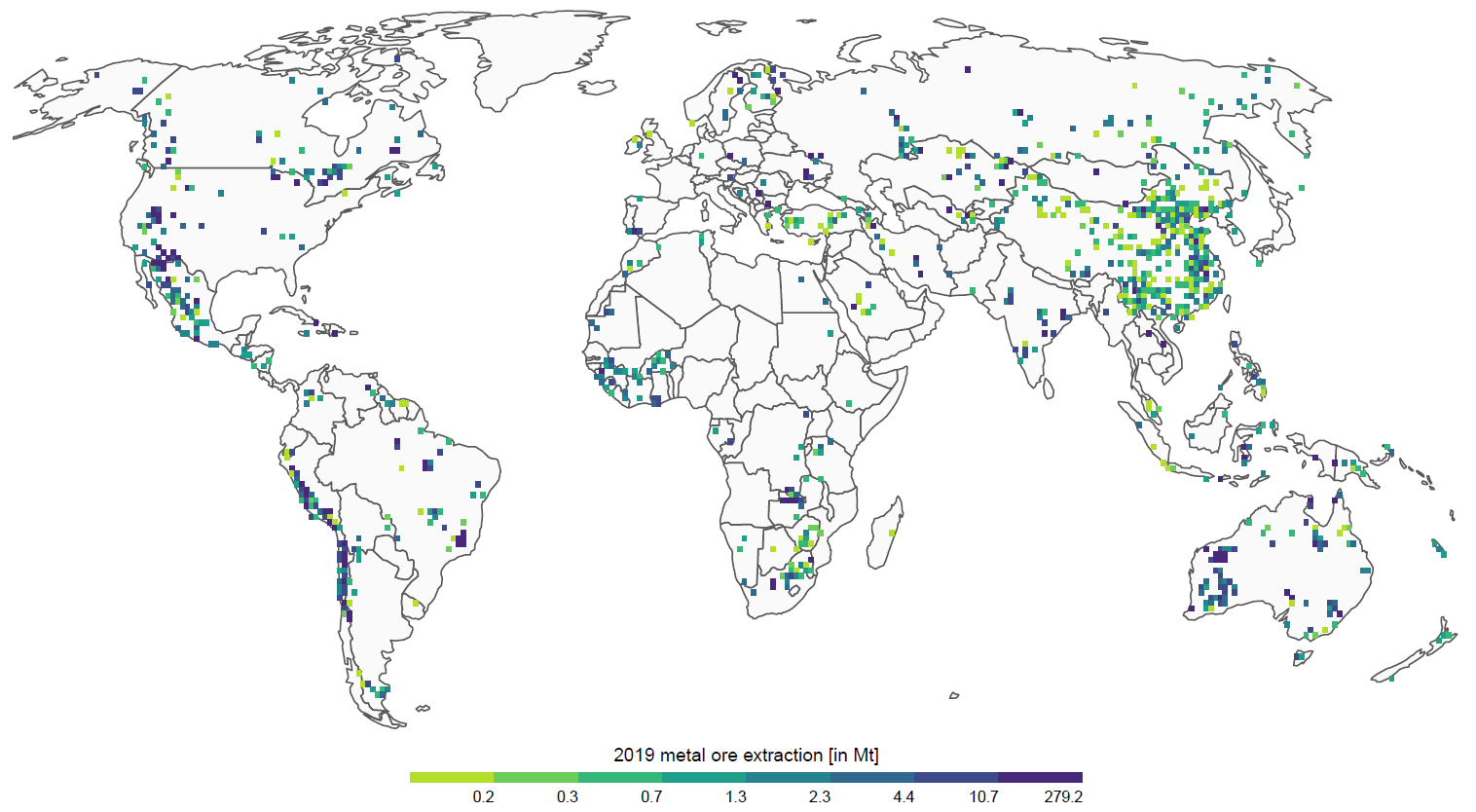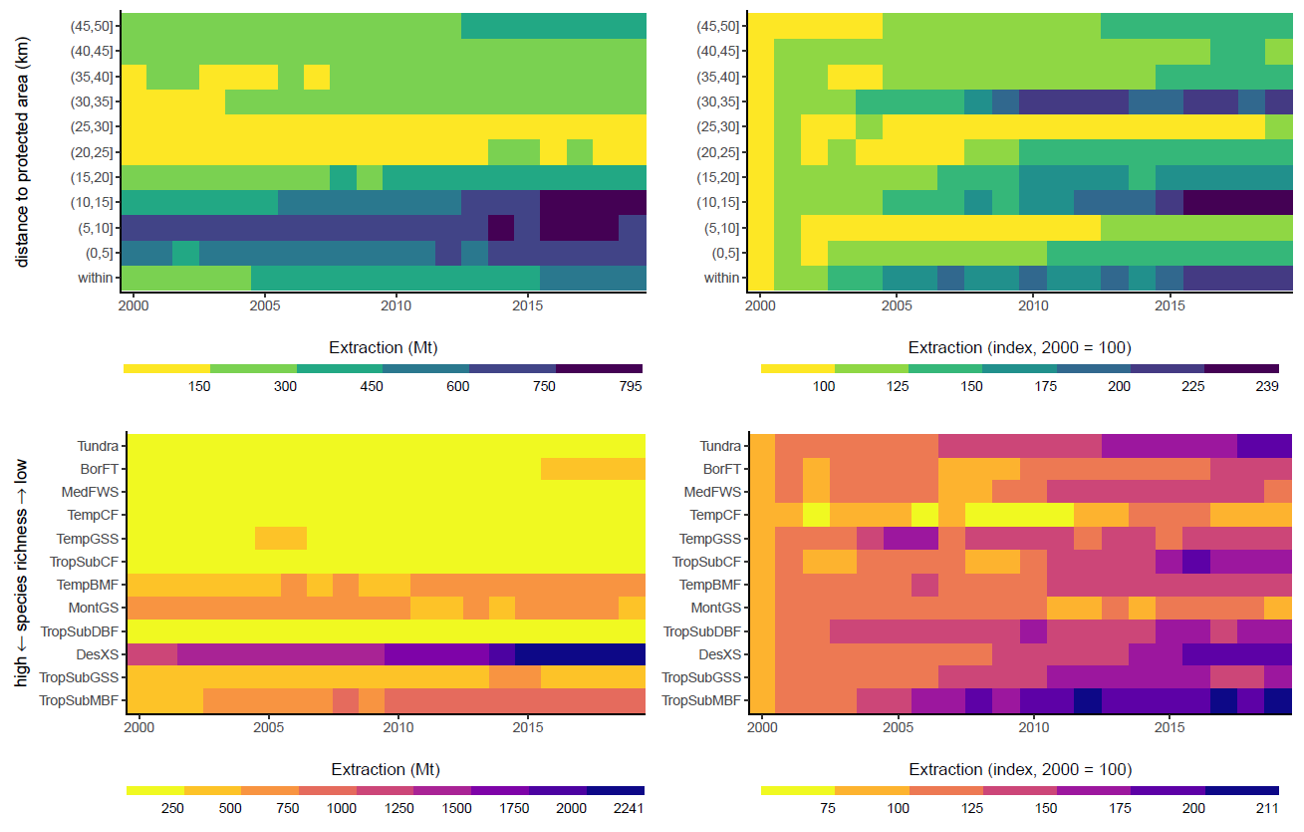Half of all metal mining worldwide occurs at less than 20km from protected lands
Sebastian Luckeneder, Stefan Giljum, Anke Schaffartzik, Victor Maus & Michael Tost
FINEPRINT Brief No. 15, October 2021
The past two decades experienced an unprecedented surge in global metal mining, dramatically increasing pressures on ecosystems worldwide. To explore the environmental risks related to the expanding mining sector on a fine spatial scale, we intersected global extraction data for nine metal ores with information about the location of protected areas, ecosystem types and water availability. Our results show that half of global metal ore extraction in 2019 took place at 20 km or less from protected territories. We also find that almost 80% of global metal ore extraction in 2019 originated from five of the six most species-rich biomes, with mining volumes doubling since 2000 in rainforest ecosystems.
This Brief is an excerpt from an open access article published in Global Environmental Change.
The demand for natural resources grew significantly over the past 20 years. Mining for metals and minerals has become indispensable to the model of economic growth currently pursued in industrialised societies. Increasing digitalisation and use of renewable energy technologies require huge amounts of metal ores [1]. At the same time, developing countries build up infrastructure in the energy, housing and transport sectors [2]. Local mining expansion and intensified production, as well as related impacts in the immediate surroundings of the sites of extraction are closely coupled to these global economic trends. By studying the local implications of the global surge in mining in a spatially explicit manner, we can better understand the current and future environmental risks related to the expanding mining sector.
In our study, we performed an assessment of how metal mining volumes are distributed across almost 3,000 mining projects worldwide, covering nine metal ores (bauxite, copper, gold, iron, lead, manganese, nickel, silver and zinc) in the period 2000–2019. Data on metal production were taken from the SNL Metals and Mining database [3]. To proxy ecosystem vulnerability, we used three spatial layers (protected areas, terrestrial biome categorisations, and water scarcity) and connected these layers with spatio-temporal patterns of extraction at the mine level.
Spatial distribution of metal mining
Metal mining is unevenly distributed across the globe. Figure 1 illustrates all metal mining activities projected into 1 degree grid cells, which equal around 110 km x 110 km at the equator. The map clearly shows that only a small fraction of mining areas reports very large extraction volumes and vice versa. Some hotspot cells yielded extraction of up to almost 300 million tonnes (Mt) in 2019, while half of the observations extracted less than 1.3 Mt.

Figure 1: Global 2019 metal ore extraction (in Mt).
Mining activities are spatially concentrated in Western Australia, Southern Africa, and along the Andes and into the Central and North American ranges of the American Cordillera. Furthermore, we find significant activities in Brazil, West Africa, India, China and Southeast and Central Asia. For China, we observe a considerable number of mining sites, but we also find that almost 80% of the observed cells show extraction volumes not larger than 2 Mt. Certain clusters appear in strong concentrations within countries, such as in Brazil or along the Zambian and Congolese border. This fact is vital to consider for the discourse about mining and its impacts, as well as for global material flow analyses. Sizeable copper flows, for example, originate from the DR Congo, with extraction occurring only in a few mines in the very south of the country. Likewise, in Brazil, 90% of all iron ore extracted in 2019 can be attributed to only ten mining sites within the states of Pará and Minas Gerais.
Surge in global metal mining in environmentally vulnerable regions
We evaluated the intensification and expansion of mining against the vulnerability of extracting regions to the harmful consequences of mining practices. Figure 2 illustrates the spatial layers of distance to protected areas and biome types, both in absolute numbers (left panels) and relative to the year 2000 (right panels).

Figure 2: Absolute metal extraction volumes (left) and relative trends since 2000 (right) related to distance to protected areas (above) and biome types (below).
In 2019, 50% of all global metal ore extraction took place within a 20 km boundary around protected territories, and 480 Mt (8%) were even mined within officially protected zones. We find that this is a pattern that has not changed fundamentally since 2000, but it has intensified. While the high concentration of metal ore extraction within a buffer of 20 km around protected areas is stable across time, it is the mining within protected areas that surged. Over the twenty-year period, mining in protected areas has risen from 225 Mt to 480 Mt, a 113% increase.
With regard to ecosystem types (biomes), deserts and xeric shrublands (DesXS) were the most exploited terrestrial biome during the past twenty years with regard to absolute extraction values. In 2019, 2,241 Mt of metal ores were mined there, followed by tropical and subtropical moist broadleaf forests (TropSubMBF, 911 Mt) and temperate broadleaf and mixed forests (TempBMF, 614 Mt). Ranking all biomes according to their richness in species, we find that five of the six most complex terrestrial biomes jointly were the origin of 79% of total metal ore extracted in 2019. While this pattern has not altered over the past twenty years and the ranking across biomes remained mostly unchanged since 2000, we see that extraction has changed in relative terms within biomes. Mining has intensified over time in all biomes except temperate conifer forests (TempCF) and montane grasslands and shrublands (MontGS). In TropSubMBF, the biome richest in species, metal ore extraction has increased by a factor of 2.1, due to, among others, the expansion of mining activities in the Central Range Papuan montane rain forests (New Guinea), the North Western Ghats moist deciduous forests and the Malabar Coast moist forests (India), and the Borneo lowland rain forests (Indonesia).
Implications for mining companies and policies
Accelerated global extraction of metals and minerals particularly threatens vulnerable ecosystems. To reduce associated risk in the short and medium term, the impacts of mining itself need to decrease. The mining industry has already developed and implemented improvements in environmental management processes and impact mitigation systems, such as progressive rehabilitation throughout the life cycle of a mine. However, higher environmental standards must be realised at the mine sites beyond corporate level commitments, as e.g. demanded by the International Council on Mining and Metals [4].
Rethinking mining governance in the extraction countries should avoid unnecessary large-scale infrastructure and avert opening up untouched spaces to settlement. Further, it is important to consider cumulative impacts across space (such as watershed regions) and over time and involve affected populations in decision making processes [5]. In addition, the ‘tele-connections’ between production in one part of the world and consumption in another need to be addressed from a global resource governance perspective that aims at reducing the huge and persistent inequalities in resource consumption.
Citation
Luckeneder, S., Giljum, S., Schaffartzik, A., Maus, V., Tost, M. 2021. Half of all metal mining worldwide occurs at less than 20km from protected lands. FINEPRINT Brief No. 15. Vienna University of Economics and Business (WU). Austria.
References
[1] Watari T, Nansai K, Nakajima K. Review of critical metal dynamics to 2050 for 48 elements. Resources, Conservation and Recycling 2020;155:104669. doi:10.1016/j.resconrec.2019.104669.
[2] Krausmann F, Wiedenhofer D, Haberl H. Growing stocks of buildings, infrastructures and machinery as key challenge for compliance with climate targets. Global Environmental Change 2020;61:102034. doi:10.1016/j.gloenvcha.2020.102034.
[3] SNL. Metals and mining database. S&P Global Market Intelligence. New York. 2020.
[4] ICMM. Mining principles. International Council on Mining and Metals. Icmm.com/mining-principles 2020.
[5] Bebbington A, Chicchon A, Cuba N, Greenspan E, Hecht S, Humphreys Bebbington D, et al. Priorities for governing large-scale infrastructure in the tropics. PNAS 2020;117:21829–33. doi:10.1073/pnas.2015636117.


